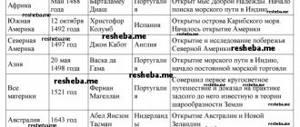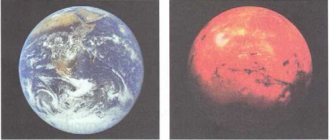Universe. Presentation for a lesson in natural history (grade 5) - presentation
Universe part 1 Natural history 5th grade Teacher: Oleynikova A.V. GBOU gymnasium 399 St. Petersburg.
Universe The Universe is outer space with celestial bodies.
Celestial bodies
Celestial bodies Stars PlanetsAsteroids CometsMeteors
What science studies celestial bodies?
Astronomy (“aster” gr. - star) is a science that studies celestial bodies. Astronomy (“aster” gr. - star) is a science that studies celestial bodies.
How are celestial bodies studied? Telescope (“tele” - far, “skopea” gr. - look, observe) is a device for studying celestial bodies.
How are celestial bodies studied? radio telescope rockets satellites interplanetary stations
Stars in the sky Stars are hot spherical gas bodies
The Sun is the closest star to us
Constellations A constellation is a group of stars arranged in a certain order in the sky. A constellation is a group of stars arranged in a certain order in the sky. There are 88 known constellations. There are 88 known constellations.
polar Star
Studying the stars has helped people: create a calendar; make a calendar; determine time; determine time; find cardinal directions; find cardinal directions; set your location on land and sea. set your location on land and sea.
Review: What celestial bodies do you know? What celestial bodies are called stars? Which celestial bodies should the Earth be classified as? How are planets different from stars?
Planet Earth. Earth is the third planet from the Sun in the solar system. Earth is the third planet from the Sun in the solar system. Its age is approximately 4.5 billion years. Its age is approximately 4.5 billion years. The earth is spherical, slightly flattened at the poles. The earth is spherical, slightly flattened at the poles.
The Earth in the minds of people Representation in ancient times View of the Earth from space
Shape of the Earth At the beginning of the 16th century. Spanish navigator Ferdinand Magellan circumnavigated the world, proving the spherical shape of the Earth
Dimensions of the Earth Eratosthenes, an ancient Egyptian scientist (3rd century BC), most accurately determined the dimensions of the Earth, proving its spherical shape. Eratosthenes, an ancient Egyptian scientist (3rd century BC), most accurately determined the size of the Earth, proving its spherical shape. The diameter of the Earth is km. The diameter of the Earth is km. The circumference of the Earth is km. The circumference of the Earth is km.
Globe Globe is a model of the Earth, reduced millions of times.
globe
Daily rotation of the Earth (around its axis)
Cardinal directions - west, east, north and south To determine the cardinal directions, first establish where north is. This can be determined by the polar star or by an instrument - a compass, which was invented in China more than 3,000 years ago.
Rotation of the Earth in orbit around the Sun
Rotation of the Earth Around its axis Around the Sun Day (24 hours) Year (365 days 5 hours 48 minutes and 46 seconds) 48 minutes and 46 seconds) 366 days - leap year 366 days - leap year
1. What is the shape of the Earth? The Earth is spherical, slightly flattened at the poles 2. What are the dimensions of the Earth? The diameter of the Earth is km, and the circumference is more than km. 3. What are the two main movements observed near the Earth? Daily and annual. 4. Give definitions: Earth's axis, equator, orbit. The Earth's axis is the imaginary line through the poles around which the Earth rotates. The equator is an imaginary line that separates the Northern and Southern Hemispheres. Orbit is the imaginary trajectory of the Earth around the Sun.
5. What cardinal directions do you know? North South West East. 6. How can you determine the cardinal directions? By the polar star or by the compass. 7. How to prove that the Earth is round? 8. Why does the change of day and night and seasons occur? 9. In which direction does the Earth rotate? From west to east.
Abstract “We are in the Universe” 5th grade geography
Lesson 8. We are in the universe
In the 5th grade, in a natural history lesson, you studied the topic “The Universe”
Slide 2. Universe
– this is the entire existing world.
It is infinite in time and space.
It contains huge clusters of stars - galaxies
.
The number of observed galaxies is about 10 billion.
Slide 3.
Our galaxy is called the Milky Way.
On a clear, moonless night, a whitish stripe is clearly visible in the sky, which the ancient Greeks called the Milky Way.
Slide 4.
Galaxies are in motion. The solar system rotates around the center of the Galaxy at a speed of about 800 thousand km per hour
Slide 5.
Our galaxy contains more than 100 billion stars. The sun is one of them. 8 large planets revolve around the Sun, including our Earth. The Greek word for planet means "wandering star." Planets do not occupy a specific place in the sky, like stars. And they wander among them, constantly changing position. This happens because they revolve around the Sun.
Slide 6.
In ancient times, people knew only five planets:
Mercury, Venus, Mars, Jupiter and Saturn.
Uranus, Neptune and Pluto were discovered using telescopes in
1781, 1846 and 1930
. For a long time, astronomers studied the planets by observing them from Earth. They determined that all the planets, except Pluto, move in circular orbits in the same plane and in the same direction, calculated the sizes of the planets and the distances from them to the Sun, formed their idea of the structure of the planets, and even assumed that Venus and Mars could be similar Earth, and there may be life on them. The launch of automatic space stations to the planets made it possible to significantly expand, and in many ways revise, ideas about the planets: it became possible to see photographs of the surface and study the atmosphere of the planets.
Slide 7.
See the title on page 23.
Slide 8 and 9
. Planetary ratio
Slide 10.
The Moon is located at a distance of about 384,400 km from the Earth. Radius: 1738 km.
The moon moves in orbit and rotates around its axis at the same speed - 28.5 days. That's why we always see only one side of her. Man's long-time dream has been to see the far side of the Moon. In 1959, Soviet scientists launched an automatic station to the Moon, which flew around it and photographed the far side.
Slide 11
. The Moon is held in orbit by the Earth's gravity, but moves away from us by 4 centimeters every year. Although the Moon is small, its gravitational force causes ocean tides on Earth and slows down the Earth's rotation speed by a hundredth of a second per century.
Slide 12.
The Sun is a huge celestial body (star), inside of which more than a million planets could fit, equal in size to our Earth.
Outline of a lesson in natural history “Flight in the Universe”
summarize and systematize students’ knowledge about the structure of the Universe and the development of the views of ancient scientists;
Lesson Objectives
Educational:
ü consolidate the basic concepts and terms on this topic; develop skills of generalization and comparison, finding cause-and-effect relationships using the example of objects studied in this topic;
ü cultivate interest in studying the world around us.
Educational:
· develop the ability to transfer learned material to a new situation;
· develop attention, memory, logical thinking;
· develop an interest in studying natural history.
· develop observation skills, the ability to listen carefully, apply acquired knowledge in a non-standard situation, develop the analytical and synthetic abilities of students;
Educators:
· foster independence, collectivism,
· ability to work with a partner, in a group;
Equipment: lesson presentation.
Equipment:
· computer with multimedia equipment
· tables and pictures depicting the starry sky, the solar system
Forms of work with the class
: frontal, individual, group.
Lesson structure
:
I.
Organizational moment (3 min.).
II.
Updating the acquired knowledge (30 min)
III.
Summing up the lesson, grading, reflection (5-7 min.).
During the classes
1.Organizing moment.
Teacher
: Dear Guys! Today you and I will make an amazing flight through the Universe. Along the way we will have to land on some planets. The launch of our ship will be made from Earth. The passengers of our ship are you, 5th grade students. Before you go into the ship's cabin and take your seat, you must purchase an air ticket, the price of which is your knowledge.
Each student, answering the question correctly, receives an air ticket. SLIDE 1
Questions about air tickets:
What natural sciences do you know? (astronomy, biology, geography, physics, etc.) In the ideas of ancient scientists, what was the center of the Universe? (Earth). What methods of studying nature do you know? (experience, measurements, observations) Who first expressed the idea that the Earth revolves around the Sun? (A. Samossky). Who created the first model of the Universe with the Sun at the center? (N. Copernicus). Who claimed that the Earth is one of the planets that revolves around the Sun? (N. Copernicus). Who was the first to use a telescope to study celestial bodies? (G. Galileo). Who discovered the moons of Jupiter? (G. Galileo). Is the Universe our Galaxy? (No. There are many such Galaxies). What are the names of the moons of Mars? (Phobos and Deimos). Which planets do not have satellites? (Mercury, Venus) What two groups are the planets divided into? (Terrestrial planets and giants). Which planets belong to the terrestrial planets? (Earth, Mercury, Venus, Mars). The smallest terrestrial planet? (Mercury). Which planet is called the red planet? (Mars). Which terrestrial planets have satellites? (Mars, Earth). Which planets are considered giant planets? (Jupiter, Saturn, Uranus, Neptune). Which planet was discovered using calculations? (Neptune). Which planet has the most satellites? (Saturn - 33). On which planet is the Great Red Spot located? (Jupiter). Which planet is the farthest in the solar system? (Neptune). Asteroids. Are these stars? (No. These are minor planets). What are comets made of? (Core, gas shell, tail). What are the names of cosmic bodies that fall to Earth? (Meteorites). What are meteors? (Flashes of light that occur when dust particles burn in the atmosphere). What stars are called supergiants? (Hundreds of times more than the Sun). What are constellations called? (Shapes of bright stars).
Teacher: Guys, you have all taken your seats, and we are setting off on our exciting flight through the solar system. It consists of 8 spherical planets. All planets glow with light reflected from the Sun. In addition to planets, the solar system includes satellites, asteroids, and many meteoroids. The Sun is a celestial body, the star closest to Earth. The mass of the Sun is 333 thousand times greater than the mass of the Earth. Basically, the Sun consists of the same chemical elements as the Earth, but there is more hydrogen in the Sun than on Earth. The energy emitted by the Sun is enormous. Only a tiny fraction reaches the Earth, but it is tens of times more than all the power plants in the world could produce. Observations of the Sun made it possible to establish that the Sun rotates around its axis and makes a full revolution in 27 Earth days. The temperature inside is 15 million degrees. The Sun is located at a distance of 150 million km from the Earth. The Sun is a giant flaming ball - the source of light and heat on Earth.
While you and I were getting ready for the flight, I met our old friend, the dreamer Petya.
SLIDE 2
In his diary he described his amazing space travels. There are a lot of errors in it. Now I suggest you listen to excerpts from his diary and find what Petya made up, i.e. factual errors.
EXCERPT #1 [slide #3]
Yesterday I was on Venus. It really is very similar to our Earth. There are many green forests of amazing Venusian trees. There are seas and oceans there too, only they have pink water. The atmosphere on Venus is very dense, there are a lot of clouds, so the Sun is almost invisible. It must have been winter on Venus, because it was cool, about -10 degrees.
there are no forests on Venus, because there is no life there at all;
— there cannot be seas and oceans with pink water, because there is no liquid water;
— there is no cold winter on Venus, because due to the dense atmosphere there is a constant greenhouse effect and the temperature is about +400°C.
EXCERPT No. 2 [slide No. 4]
I returned from Mars this evening. Wonderful planet! There I was met by friendly Martians. These people mine iron, which is very abundant on Mars. I was taken on an excursion to the highest volcano in the solar system - Olympus volcano, it has a height of 100 km. Mars is a very large planet - 5 times larger than Earth. Through a telescope we observed its satellites from Mars - all 10 of them were very clearly visible.
— They couldn’t meet the Martians, because there is no life on Mars; — Olympus volcano has a height of 27 km;
- in fact, Mars is much smaller than Earth - it has only 2 satellites
EXCERPT #3 [slide #5]
Last week I flew to Jupiter. The journey was not at all tiring, because Jupiter is very close to the Earth. As I approached the planet, I noticed that it was all checkered. The landing was successful. Walking without a spacesuit. I saw a big red spot - this is such a huge sea, I drove along its shore in a car. By lunchtime it became hot +30°C, so I flew home.
— Jupiter is very far from Earth;
— Jupiter looks sort of striped due to the layering of the atmosphere;
— you can’t land on Jupiter, it doesn’t have a solid surface, so you can’t drive a car; — it’s impossible to walk there without a spacesuit, because there is no oxygen necessary for breathing
-The Great Red Spot is an atmospheric vortex; — it couldn’t get hot by lunchtime; Jupiter maintains a constant negative temperature (about -150°C).
EXCERPT No. 4 [slide No. 6]
Yesterday I visited Saturn. Wonderful planet! I liked it there very much! First I landed on Saturn on the outer ring of the planet. A whole amusement park has been built there: swings, carousels, a shooting gallery and much more. Then I flew to Saturn itself. But he stayed there for a very short time, night began to fall, because the day on Saturn is very short - only 10 Earth hours. I managed to see that there are many wheat fields on the planet. He flew around the planet - it was fast, because it is very small, and did not meet a single satellite. There probably aren't any.
— you can’t land on Saturn’s rings and build an amusement park there, because they are formed by constantly moving particles of snow, ice, and dust;
there cannot be wheat fields, because the planet does not have a solid surface;
- this is a giant planet;
— I couldn’t help but see the satellites, Saturn has about 30 satellites
EXCERPT No. 5 [slide No. 7]
Flew to Uranus in half a day. A beautiful planet of yellow color, it has no rings and is small in size. I couldn’t land; I couldn’t find a solid surface. In addition, the ship began to heat up, because on Uranus it is hot as an oven!
— it will take a very long time to fly to Uranus, because it is very far away;
— has rings, like all giant planets, but they are barely noticeable;
- has huge dimensions;
— the spacecraft cannot heat up, because Uranus has a constant low temperature of 218°C
EXCERPT #5 [slide #8]
Returned from Pluto. The flight to it is very far, almost 2 days, because it is located on the outskirts of the solar system. When approaching Pluto, I almost collided with one of its 40 satellites. Pluto is slightly smaller in size than Saturn, and has the same red surface as Mars.
— Pluto has been classified as a dwarf planet since 2006
- Pluto has only one satellite - Charon;
- Pluto is 6 times smaller in size than the Moon;
— the true color of Pluto’s surface is unknown, because due to its remoteness it has been very little studied.
After his travels, Petya drew a map of the solar system in his diary,
[slide number 9]
Let's check if everything in it is correct?
SLIDE 10
Well done! Found all of Petya's Fictions!
Teacher: To take a break from the screen, let's do some exercises for the eyes.
SLIDE No. 11 No. 12
Teacher: Find out our next task from the photographs of scientists - space explorers
Get full text
Geseppe Piazzi Edmond Halley Galileo Gagarin
SLIDE No. 13 No. 14
Teacher:
And now we will land on Mars in the equator region. There are mysterious neighbors of the Sun in outer space - asteroids, comets, meteorites, meteors. In history, the fall of the Tunguska meteorite on the territory of our country is known. Having fallen to Earth, a meteorite crumbles into small pieces. Yes. This terrible phenomenon occurs extremely rarely. According to observational data, most meteorites are of asteroid origin. Most of them are small in size.
Slides No.
| Sign | Asteroids | Comets | Meteora | Meteorites |
| Translation | star-like | hairy | floating in the air | |
| Diameter | Tens of kilometers | Tens of kilometers | small | Tens of kilometers |
| Origin, structure | Remnants of the building material of the solar system | Core, gas shell, tail | Cosmic dust | Asteroid debris |
| Orbit | Around the Sun | Elongated orbits | In interplanetary space | In interplanetary space |
Teacher:
Our Galaxy is only a small part of the Universe.
There are many Galaxies in the Universe that are beyond our reach. In the meantime, we are returning to Earth, complete the Task Define the terms:
Universe -
Galaxies -
Constellations -
We are approaching our planet Earth, tell us about it
Frontal work with students.
Congratulations on your safe landing at the cosmodrome. You have to go through customs control and fill out a declaration in the form of a crossword puzzle.
Crossword
1. The second planet from the Sun. 2. The closest star to our planet. 3. What did the ancient Greeks call “hairy”? 4. Who created the first telescope? 5. Which giant planet has a red spot discovered? 6. Earth satellite. 7. Who was the first to propose the modern model of the Universe? 8. What book did Aristotle write in 8 volumes? 9. Areas of the starry sky.
Teacher: Thus, we completed our flight into outer space, an amazing and wonderful journey ended with a safe landing on Earth. I think that you guys and our guests will have an unforgettable impression of our flight. When leaving the office, please stick a piece of paper with a smiley face that matches your mood. Learn, dare and I hope that you will make a real flight into space. Good luck and success to you.





